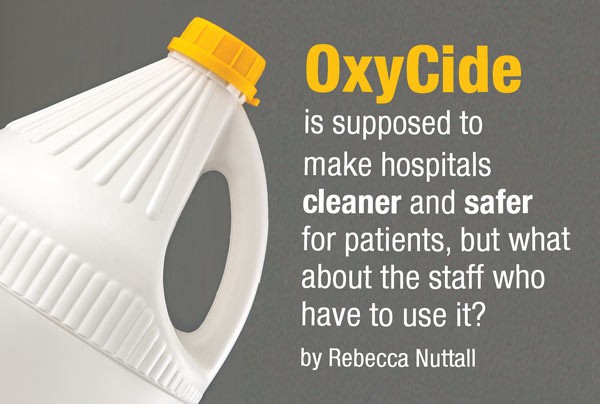When Robert Ross has to use the cleaning solution OxyCide as part of his job as a housekeeping employee at UPMC Magee-Women's Hospital, it's not a pleasant experience.
"It burns my eyes, it makes them water. It burns my throat," says Ross. "The best way to describe it is it's like working with onions. You have no relief, unless you take a break and go some place that's well ventilated so you can get some air."
OxyCide, a relatively new hospital-cleaning product, was selected as the primary cleaning solution in nearly 20 UPMC facilities last spring. Since that time, some employees say they and their co-workers have experienced a number of adverse side effects when using the product.
"A lot of my co-workers have complained about respiratory issues, like they were having trouble breathing. A lot of them would complain about their eyes being irritated," says Justin Sheldon, a housekeeper at UPMC Presbyterian Hospital. "I'm concerned about the health effects that this product poses to not only my coworkers, but to the patients."
Last month, Sheldon filed a complaint about the hospital's use of OxyCide with the Occupational Safety and Health Administration, a federal agency that regulates workplace safety. Officials at OSHA's Pittsburgh Area Office tell City Paper that it "opened an inspection" of UPMC on Jan. 22.
The complaint raises questions about the use of toxic chemicals used to clean health-care facilities, where powerful products are necessary to kill the germs and bacteria that can cause infection. According to Ecolab, the makers of OxyCide, the product has proven effective at killing infection-causing "clostridium difficle spores." According to a recent study in the Journal of the American Medical Association, treating C. difficile infections cost the health-care industry $1.5 billion each year.
And UPMC isn't alone in its use of OxyCide. The chemical is also used at facilities that are part of the Allegheny Health Network (which includes Allegheny General and West Penn hospitals). After confirming that OxyCide is used in Allegheny Health Network hospitals, a spokesperson did not respond to additional questions about the product's use in these facilities.
So how do hospitals weigh the costs and benefits of cleaning solutions in an effort to ensure both patients and employees are protected? In the case of OxyCide, employees say a product that is supposed to keep patients from getting sick, is making them sick.
When OxyCide hit the market in 2013, it was advertised as a non-bleach alternative cleaner for daily use in health-care settings. According to a 2012 study, the use of OxyCide resulted in a 36.5 percent reduction of bacteria on hospital surfaces when compared to other disinfectants.
In a statement from Ecolab in response to an email from City Paper regarding the OSHA complaint, spokesperson Roman Blahoski said OxyCide "is an EPA-registered product that has undergone rigorous testing for use in health-care environments."
According to the Centers for Disease Control and Prevention, approximately 1.7 million people acquire health-care-associated infections annually, resulting in 150,000 deaths. Infections caused by C. difficile are linked to 14,000 deaths each year.
"OxyCide is proven effective against several harmful bacteria and viruses that are known to cause health-care-associated infections," says Blahoski. "Hospitals across the country are finding that OxyCide is a key component of their programs to battle health-care-acquired infections."
This criteria factored into UPMC's decision to use the product locally.
"We are committed to maintaining safe, sanitary facilities for our patients and employees," says UPMC spokesperson Gloria Kreps. "Ecolab, the manufacturer of OxyCide, represents that OxyCide is an EPA-approved cleaner that is safe when used correctly and reduces patient exposure to dozens of dangerous organisms. We have no reason to doubt them."
In response to the OSHA complaint filed by UPMC employees, Kreps says, "Though it is true that the product has a vinegar-like scent, we believe it is the right thing to do for our patients."
And added, "As with any product, its safe use by our employees is of utmost importance and any issues regarding its safe use are investigated immediately."
OxyCide is advertised as a safer alternative to other products because it is dispersed from a container that eliminates the need for manual pouring and mixing. The product gets dispensed via a container that dilutes the chemical solution with water. But even diluted, employees say, the disinfectant is powerful.
In an employee-conducted survey of 244 UPMC workers, 81 percent of respondents indicated they had suffered negative effects from OxyCide. The most common effects were a runny or burning nose, which was experienced by 56 percent of respondents; and headaches, which were experienced by 50 percent. In addition, 6 percent reported other effects, including nose bleeds and vomiting.
"[OxyCide is] so dangerous. It's putting a lot of us at risk, and not just the health-care workers, but doctors and patients as well. It's about everyone in the hospital," says Ross. "Everywhere this product is being used it should be gotten rid of."
Last year, employees at the University of Vermont Medical Center had the same thought after OxyCide was introduced to their facilities.
"Some of our members started complaining of fairly severe symptoms," says Laurie Aunchman, president of AFT-Vermont, a union that represents nurses.
According to Ecolab, the product's active ingredients are hydrogen peroxide and peracetic/peroxyacetic acid. The product's safety-data sheet lists a number of precautionary measures for using the product if it is handled in its non-diluted form.
If handled "as sold," the sheet says users should wear protective clothing like goggles, gloves and an apron. Users should also wear a respirator "when ventilation is inadequate and occupational exposure limits are exceeded."
But these recommendations are not the same for use of the chemical in its diluted form, which is what is typically handled by hospital workers. While the data sheet does not recommend protective gear when using OxyCide in its diluted form, it does recommend using it only with "adequate ventilation."
These recommendations don't jibe with what nurses at the Vermont Medical Center were experiencing.
"Even though the product has been tested, when people start having negative reactions, you have to look at whether this is safe. I don't care what the literature says that the company is giving you," Aunchman says. "I've seen rashes. One housekeeper in the area I work in, she was wearing gloves, but it was above the glove line."
For these reasons, last month VMC stopped using OxyCide.
"We did our own thorough review and pilot program with this product prior to starting to use it throughout the facilities at the end of September," says Mike Noble, spokesperson for VCM. "A number of our staff began to report they experienced skin and/or respiratory irritation associated with this product."
While staff at VMC filed an OSHA complaint, the decision by administrators to stop using OxyCide came before OSHA's ruling, which has yet to be released and is expected later this month.
"In response, we tried to address these concerns by adjusting our application methods. Even after these adjustments, we continued to receive reports of staff being negatively affected, therefore we made the decision to discontinue use of the product in January," says Noble. "We felt that the expected benefits realized by the use of OxyCide simply do not outweigh the impact on our team or the potential impact on patients."
Some say all chemicals should undergo more research before being made available for use. According to Health Care Without Harm, an organization focused on improving sustainability and environmental justice in the health sector, the laws governing industrial chemicals do not require adequate testing of new and existing toxic chemicals and materials.
"The amount of scientific research on chemicals varies greatly, depending on the specific chemical in question," says Rachel Gibson, director of the Safer Chemicals Program of Health Care Without Harm. "This is because of our broken federal regulatory system that allows chemicals on the market without requiring manufacturers to demonstrate that they are safe."
The Safer Chemicals Program helps hospitals find sustainable alternatives to cleaning products, but they do not focus on disinfectants like OxyCide because of the important role disinfectants play in infection control.
"Disinfection can be a more sensitive area for hospitals to address and more difficult to navigate the tradeoffs between infection-control and potential toxic-chemical exposures, especially for those hospitals newly working on the issue of toxic chemicals," says Gibson.
While Gibson said she wasn't familiar with research on peracetic acid, one of the active ingredients in OxyCide, she did point to an April 2014 report by the San Francisco Department of the Environment that says there is a link between the ingredient and asthma.
William Griffin, president of Cleaning Consultants Inc., a Seattle-based company that provides companies with information on the cleaning industry, frequently works with health-care facilities. He says more hospitals are moving toward using sustainable products with fewer toxic chemicals.
"The trend is definitely toward less hazardous, less toxic products," says Griffin, who has more than 30 years of experience in the cleaning industry. "Health care is a very good leader in that area of transitioning away from the more hazardous product to the safer products."
While he's a proponent of "green" and "sustainable" cleaning products that have lower environmental impacts, he says more-toxic products are necessary in the health-care industry. He also says any product can be hazardous if the correct precautions aren't taken.
"That's why they have goggles and that's why they have protective equipment," says Griffin. "In health care, we have viruses and bacteria that will kill people, and the cleaner's job is to remove those. So the product has to be stronger than the virus. That's why they're disinfectants, because they kill things. So if you expose yourself to it, you're going to get a reaction. That's why you wear the gloves and the goggles."
But at the local UPMC hospitals, some employees say the precautions they were trained to use when handling OxyCide are not preventing the negative side effects they've experienced.
"I don't think it's a safe product for us to use despite that people say it's within standards," says Sheldon, the UPMC employee who filed the OSHA complaint. "It's causing so many problems that, quite frankly, it needs to be removed."















